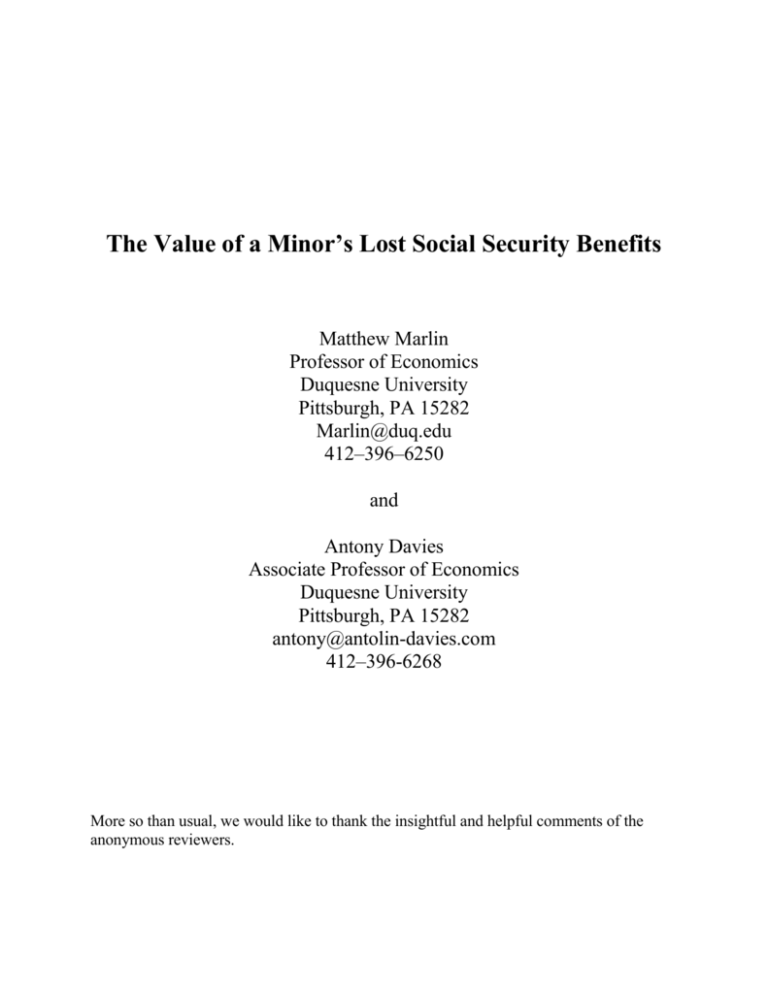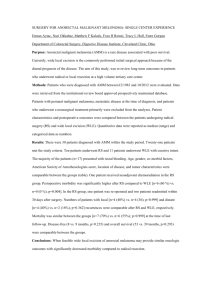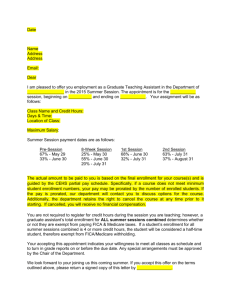The value of a minor`s lost social security benefits
advertisement

The Value of a Minor’s Lost Social Security Benefits Matthew Marlin Professor of Economics Duquesne University Pittsburgh, PA 15282 Marlin@duq.edu 412–396–6250 and Antony Davies Associate Professor of Economics Duquesne University Pittsburgh, PA 15282 antony@antolin-davies.com 412–396-6268 More so than usual, we would like to thank the insightful and helpful comments of the anonymous reviewers. Despite controversies surrounding the inclusion of lost Social Security benefits in estimates of economic loss associated with wrongful injury and death analyses, there may be instances where the forensic analyst wishes to include estimates of their value. Through the estimation of such losses for minors with no work histories we confirm previous findings that show how the values vary with demographic characteristics as well as supporting prior studies that find no correlation between the net present value of such losses and employer FICA contributions. 1 1. Introduction Including the value of lost Social Security (SS) retirement benefits when determining the economic damages involved in a tort involving wrongful injury or death is controversial. Taylor and Ireland (1996) contend that federal case law precludes their inclusion on the grounds that such benefits are “noncontractual” and therefore speculative. Prior studies question their inclusion because, depending on the demographic circumstances, their net value may be negative (Rosenmand and Fort (1992) and Fractor, et al (1997)). Martin (2008) notes that the exclusion of SS benefit losses is sometimes due to the difficulty of calculation and that when included, forensic analysts will sometimes (wrongly) use the employer’s contribution as an estimate of the loss. By including an analysis by Rodgers (2008) that explains how such losses are appropriately estimated he does, however, lend credence to their inclusion. Despite the controversy, there may be instances where there is a desire or need to value SS benefits. As has been often pointed out (Boskin, Kotlikoff, Puffer and Shoven, 1987, and Rodgers 2008), such calculations are complex and values vary considerably with income, work history, life expectancy, marital status, etc. There is no one magic formula that can be universally applied in all instances. For example, Rodgers’ results differ from those reported here, in large part because he assumes a spouse and we assume a single plaintiff. Although a couple of estimates for single individuals are included in Boskin, et al, they also concentrate on married couples. The present analysis estimates the value of lost Social Security retirement benefits for a single minor who has not yet entered the workforce and has no earnings history. Admittedly narrow in focus, in many respects it represents an updated subset of the cases presented by Boskin, et al while adding the dimension of race. 2 Although no prior studies have focused exclusively on minors, the current research is consistent with previous studies that conclude that “standard” forensic analyses (as depicted in Martin) could lead to the omission of SS as a component of economic loss: could, not should, because there are instances where estimated losses are positive. Furthermore, the results confirm the previous findings (Roseman and Fort, 1992 and Rodgers 1999) that show the “FICA tax method” of estimating SS losses by multiplying lost earnings times employer contributions results in estimates that are in no way correlated with the net present value of any losses. The paper is structured as follows. Part II presents the assumptions and research design. Part III presents the estimates of loss for minors under assumptions regarding income, the age at which benefits begin, and demographic characteristics. The final section presents a summary of the findings. 2. Assumptions and Research Design An analysis of lost SS benefits requires a multitude of assumptions: the wages upon which the SS payroll tax are levied, the number of years in the worklife expectancy (WLE), the life expectancy over which benefits will be received, and the age at which one begins to receive retirement benefits (either full retirement age (fra), early retirement (era), or delayed retirement age (dra)). This analysis makes the following assumptions: Annual earnings in 2008 equal, alternatively, the designated maximum, average, and low levels assumed by the Social Security Administration ($101,700, $41,835, and $18,826). 3 Earnings increases are those rates projected in the Intermediate Forecast used by the Old Age Survivors and Disability Insurance (OASDI) Trustees. They vary between 3.8% and 4.1% between 2009 and 2017, before settling at 3.9% per year through 2085,1 n is the worklife expectancy (WLE) or number of years, beginning at age 22, that the plaintiff could have been expected to work. The full WLE is assumed to be 35 years (to be discussed further, below). The full retirement age is currently 67 for a worker who was 22 years old in 2008. Benefits are estimated for full (fra), early (era) and delayed (dra) retirement ages. le is life expectancy for a 22 year old as reported by the National Center for Health Statistics (71 for black males, 76 for white males, 77 for black females and 81 for white females).2 SSBfra is the single retirement benefit (Primary Insurance Amount or PIA) at full retirement age as determined by using the Social Security Administration’s ANYPIA calculator.3 SS contributions equal 5.3% of payroll wages. Although the total FICA tax equals 7.65%, 1.45% is earmarked for Medicare and 0.90% for the Disability Trust Fund. Only the remaining 5.3% is dedicated to funding retirement benefits. The SS cost of living adjustment is 2.8% per year (this is the average over the past 25 years as well as the Intermediate CPI increase forecast used by the Social Security Administration).4 d, the discount rate, is the interest rate in the OASDI Trustees’ Intermediate forecast. It varies between 5.1% and 5.8% from 2009 to 2017 and then settles at 5.7% through 2085. In 1 2 3 4 www.ssa.gov/OACT/TR/TR07/V_economic.html#wp188118 www.cdc.gov/nchs/data/nvsr/nvsr54/nvsr54_14.pdf www.ssa.gov/OACT/anypia/anypia.html www.ssa.gov/OACT/COLA/colaseries.html 4 contrast, Rodgers (2008) uses the historic average yield on government bonds and Boskin, et al, use arbitrary rates of 2, 3, and 4%. An advantage of the rate used here is that the source is the same used for the wage growth rate, hence the resulting net discount rate is constructed using “apples and apples” instead of “apples and oranges”. All benefit calculations are for a single individual and disability benefits are not considered. Because it would be highly unlikely (when preparing a damages estimate) to assume that a minor will be married and/or disabled when grown, the related issues raised by Durham (1993) can be ignored. The plaintiff was born on July 1, 1986 and begins work in 2008 on his or her 22nd birthday. The present value of SS benefits is then calculated as: (1) Where contributions and benefits are estimated as: (2) (3) , , or , depending on the age at which benefits begin. 3. Estimating the NPV of Lost SS Benefits Two steps are involved in calculating an individual’s SS retirement benefit or Primary Insurance Amount (PIA). First, the entire income stream over the worklife is indexed for inflation and the highest 35 years of indexed earnings are averaged to arrive at the Average Indexed Monthly Earnings (AIME). Even if the individual is working for a full 45 years beginning at age 22 and ending at age 67, lifetime earnings for the lowest 10 indexed earnings years are dropped 5 before the AIME is calculated. The PIA is then calculated as 90% of the first $711 of the AIME plus 32% of the AIME between $711 and $4,288 plus 15% of the AIME above $4,288. (The values $711 and $4,288 are referred to as the “bend points” and these values are adjusted each year based on the change in the “average wage indexing” series.) When estimating the lost value of earnings and/or benefits the analyst must assume a worklife expectancy (WLE) for the individual. The average WLE for a 22 year old female is 31 years and for a 22 year old male it is 36 years (Skoog and Ceicka, 2001). This includes time out of the labor force due to illness, injury, premature death, or voluntary withdrawal from the labor force for any reason. The estimates discussed here use a WLE of 35 years for males and females because in most cases it maximizes the NPV of the lifetime benefits, and the present analysis is interested in determining the maximum benefit for a minor. The NPV is maximized at 35 years because, assuming constant wage increases, after 35 years of reported earnings the monthly benefit remains essentially constant while FICA taxes continue to be levied on earned income. The result is decreasing net benefits for each successive year. Although a WLE of 35 years overstates the estimated WLE of all females by about five years and understates the WLE for all males by about one year, it provides a reasonable working estimate. The above assumptions and equations were used to estimate the present value of the FICA contributions and the NPV of lifetime SS benefits for a minor. It is assumed that the individual begins work at age 22 and works 35 years until age 57. He or she then exits the labor force and begins to receive benefits at either age 62 (era), 67 (fra), or 70 (dra). Taking benefits early at age 62 results in a 30% reduction in the Primary Insurance Amount each year; delaying benefits beyond age 67 adds an 8.0% premium to the benefit each year through age 70. 6 The results (rounded to the nearest $100) for different genders and races and different assumed incomes are shown in Tables 1 (era), 2(fra), and 3 (dra). Negative values in the Table indicate a negative return to the individual; he or she would have paid more in FICA taxes than he or she would have received in benefits. In such instances there is no loss of SS benefits. Four points are worth noting. First, it pays to begin receiving benefits at as early as possible. The longer number of years over which the benefits are received outweighs the increased amount of the PIA. Only low and average earning females experience a positive net SS benefit if they wait until age 70 to begin collecting. The option is an especially poor choice for black males with a life expectancy of 71 years – the NPV of the loss is about $132,500. Second, the NPV of benefits is inversely related to income. This is not surprising since the formula for calculating the PIA from the AIME is skewed and redistributes benefits from high income to low income wage earners. In all instances a high wage individual will experience a net lifetime loss, and with the exception of black males, all low wage individuals experience a small, but positive gain if they begin collecting benefits by age 67. Third, the NPV of the SS benefits is positively related to life expectancy. This is again not surprising: a black male (BM) with a life expectancy of 71 years who begins collecting benefits at age 67 will only be collecting benefits for four years. Only by being a low earner beginning to collect benefits at age 62 would a black male experience a positive NPV of benefits, and then it would only be an estimated $1,600. For all other income groups and retirement ages his gross benefits will be less than his contributions resulting in negative net benefits. In contrast, a white female (WF) with a life expectancy of 81 years will collect benefits for 14 years. Other than for those in the top income class, this is long enough to realize a net benefit. 7 The fourth and final point is that the present values of the FICA contributions are greater than the net benefits in each case; the only instance where the two are even close is for a low income WF. FICA contributions can be interpreted in two ways, either as the employee contribution to be subtracted from gross SS benefits to arrive at net benefits or as an estimate of the value of lost employer contributions when calculating the loss using the “FICA tax method.” Viewed from the latter interpretation it is obvious that this method of estimating the loss overstates the actual net loss in each and every instance. For example, a high income BM actually has a net loss ranging from $61,500 to $132,500, yet the FICA tax method would estimate a positive foregone benefit of over $145,000 over a lifetime, a difference of almost a quarter million dollars. The accompanying Figures 1, 2 ,and 3 (and corresponding Tables 4, 5, and 6) show how the NPV changes with years of WLE and life expectancy if it is assumed that benefits begin at the full retirement age. The highest dotted line in each graph is the NPV for a WF and the lowest dotand-dash line is that for a BM. The declining dotted and dashed lines for each year in Figure 1 indicate that the NPV of benefits for those in the highest income classes will decline as assumed WLE increases and that for any reasonable WLE the NPV will be negative, regardless of life expectancy. For example, the values on Figure 1 associated with a WLE of 35 years would correspond to the bottom row of Table 2. Figure 2 (Average Income) shows that the NPV for the long-lived WF increases slightly, peaks at a 35 year WLE, and then declines after that. The NPV for the BF is marginally positive for the same WLE and the NPVs for males are negative for relevant WLEs. Figure 3 (Low Income) shows that because of the skewed (redistributional) nature of SS benefits those in each category of the low income group, except the short-lived BM, could be expected to receive a positive net benefit from the SS program. 8 Included in each of the graphs is the estimate of present value of the FICA contributions (5.3%) made by both the employee and the employer (the solid line). The values on the line are those that an analyst using the FICA Tax Method would use to estimate the value of lost SS benefits. The vertical difference between the FICA Tax line and the lines showing the NPVs represent the difference between the estimates generated using the two different techniques. As is readily apparent, the FICA tax method significantly overstates the value of the lost benefits in cases where the projected income is at the maximum or average levels, and the overestimate increases with WLE. The FICA tax method generates an estimate equal to the NPV of losses only when the NPV line intersects the FICA tax line. As is also readily apparent, there is only one instance (a low income white female working about 30 years) that this occurs. If a WLE of 35 years or more from age 22 is assumed, then the FICA tax method will overstate the actual net value of the loss in every instance. DeBrock and Linke (2002) argued that even if the FICA tax method is not an appropriate measure of individual loss, “…the social good dimension of the FICA programs is valuable to the average worker and should be included in a lost earnings analysis” (p. 171). The implication is that the difference between the FICA tax amount and the NPV of benefits represents a form of a public good. If this is indeed the case, then the analysis presented here would imply that the value of this public or social good varies with income, gender, and race: rich black men generate a substantial amount of such social good while poor white women generate very little. 9 4. Conclusion In twenty-one of the thirty-six scenarios shown in Tables 1 through 3 there is no economic loss experienced by a minor when the viewed over a reasonable WLE. Estimates of future earnings that assume a high wage for anybody should not include SS losses as part of the damages estimate. If anything, (consistent with Rosenman and Fort) damages should be reduced to account for the gains that will occur because the plaintiff would not have to experience the net loss associated with the lifetime participation in the SS program. In some of the other scenarios there are economic losses, and in some there are no losses; however the losses are minimal reaching a peak of about $32,000 for a white female with an average income who collects benefits beginning at age 62. The age at which it is assumed the minor would begin receiving benefits will make a difference in the amount (if any) of the loss. If the forensic expert assumes an early or full retirement age, then a case can be made for small SS economic losses for low and average earners. The above estimates are not intended to provide actual estimates in any personal injury or wrongful death case. Rather they are intended to show that in instances where an analyst is projecting the lost value of SS benefits to a minor there is a minimum of loss. While estimates using different parameters may result in larger losses than estimated here, one should evaluate estimates of lost SS benefits for minors that exceed around $30,000 with a critical eye. Given that the estimated lifetime losses of income and benefits (and possibly household services) for a minor will probably be in the seven figure range, an analyst might or might not be inclined to include an estimate of lost SS benefits. On the one hand “purity” might oblige the analyst to include a $30,000 SS loss on top of a $1,000,000 damage estimate; on the other hand, “practicality” might lead the analyst to ignore it. However, the results strongly indicate that no 10 preference for purity versus practicality should allow the analyst to estimate losses using the FICA tax method. 11 References Boskin, Michael J., Laurence J. Kotlikkoff, Douglas J. Puffert, and John B. Shoven,” Social Security: A Financial Appraisal Across and Within Generations,” National Tax journal , Vol 40. No. 1, pp. 19 -34. DeBrock, Larry and Charles M. Linke, “Valuing Employer FICA Contributions in an Analysis of Diminished Earnings Capacity,” Journal of Forensic Economics, Vol. 15, No. 2 (2002), pp. 165-72. Durham, Stephen E. “The Correct Value of Social Security Contributions in Personal Injury and Wrongful Death Settlements: A Comment,” Journal of Forensic Economics, Vol. 6, No. 2 (1993), pp. 151-52. Fractor, David T., Daniel L. McConaughy, and G. Michael Phillips, “The Impact of Earnings Loses on Future Social Security Benefits: Much Ado About Nothing?” Litigation Economics Digest, Vol.2, No. 2 (1997), pp. 158-67. Martin, Gerald D, Determining Economic Damages (Costa Mesa, California: James Publishing, Inc., 20th Revision, 2008). Rodgers, James D. “Estimating the Loss of Social Security Retirement Benefits.” The Earnings Analyst, Vol. 3, No. 1 (2000), pp. 3-29. Rodgers, James D. “Estimating the Loss of Social Security Retirement Benefits,” Section §427In Martin, Gerald D., Determining Economic Damages, (2008), pages 4-19 to 4-26. Robert Rosenman and Rodney Fort, “The Correct Value of Social Security Contributions in Personal Injury and Wrongful Death Settlements,” Journal of Forensic Economics, Vol. 5, No. 2 (1992), pp. 149-58. Skoog, Gary R. and William E. Ciecka, “The Markov (Increment-Decrement) Model of Labor Force Activity: Extended Tables of Central Tendency, Variation, and Probability Intervals.” Journal of Legal Economics, Vol. 11, no 1, (2001), pp. 23-87. Taylor, Paul C. and Thomas Ireland, “Accounting for Medicare, Social Security, Benefits and Payroll Taxes in federal Cases: Federal Case Law and Errors by Many Forensic Economists.” Litigation Economics Digest, Vo. 2, no 1, (1996), pp. 79-88. 12 Figure 1. 13 Figure 2. 14 Figure 3. 15 Figure 4. 16 Table 1 NPVs of Social Security Benefits for a 22 Year Old (Early Retirement at Age 62) Income Category Low Average Maximum FICA Contributions (5.3%) $26,700 $59,300 $145,100 71 (Black Male) $1,600 -$7,400 -$61,500 Life Expectancy to Age: 76 77 (White Male) (Black Female) $14,500 $13,600 -$27,600 $16,900 $17,500 -$21,500 81 (White Female) $25,800 $31,900 -$500 17 Table 2 NPVs of Social Security Benefits for a 22 Year Old (Full Retirement at Age 67) Income Category Low Average Maximum FICA Contributions (5.3%) $26,700 $59,300 $145,100 71 (Black Male) -$9.800 -$31,500 -$100,300 Life Expectancy to Age: 76 77 (White Male) (Black Female) $8,800 -$800 -$50,900 $12,300 $4,800 -$41,800 81 (White Female) $25,100 $25,900 -$7,900 18 Table 3 NPVs of Social Security Benefits for a 22 Year Old (Delayed Retirement at Age 70) Income Category Low Average Maximum FICA Contributions (5.3%) $26,700 $59,300 $145,100 71 (Black Male) -$21,900 -$43,100 -$132,500 Life Expectancy to Age: 76 77 (White Male) (Black Female) -$100 -$6,200 -$74,400 $4,000 $500 -$63,700 81 (White Female) $19,000 $25,800 -$23,900 19 Table 4 PV of Contributions and Benefits for Maximum Wage Earner (FRA at 67) WLE Age 22 PV of Contributions 11 13 15 17 19 21 23 25 27 29 31 33 35 37 39 $55,185 $64,194 $72,882 $81,270 $89,375 $97,206 $104,776 $112,087 $119,153 $125,979 $132,575 $138,948 $145,103 $151,051 $156,799 Net PV of Benefits After Working WLE Years If the Life Expectancy is: 71 Years 76 Years 77 Years 81 Years $23,197 $48,789 $53,494 $71,058 $25,985 $54,652 $59,922 $79,596 $28,765 $60,499 $66,333 $88,112 $31,548 $66,354 $72,752 $96,639 $34,329 $72,201 $79,163 $105,155 $35,681 $75,045 $82,282 $109,298 $36,983 $77,783 $85,284 $113,286 $38,288 $80,529 $88,295 $117,285 $39,590 $83,267 $91,297 $121,273 $40,896 $86,013 $94,308 $125,272 $42,198 $88,751 $97,310 $129,260 $43,500 $91,490 $100,312 $133,248 $44,805 $94,236 $103,323 $137,247 $44,816 $94,258 $103,348 $137,280 $44,823 $94,273 $103,365 $137,302 20 Table 5 PV of Contributions and Benefits for Average Wage Earner (FRA at 67) WLE 11 13 15 17 19 21 23 25 27 29 31 33 35 37 39 Age 22 PV of Contributions $22,622 $26,295 $29,842 $33,268 $36,579 $39,778 $42,869 $45,856 $48,742 $51,530 $54,225 $56,828 $59,343 $61,774 $64,122 Net PV of Benefits After Working WLE Years If the Life Expectancy is: 71 Years 76 Years 77 Years 81 Years $14,203 $15,339 $16,472 $17,608 $18,745 $19,881 $21,018 $22,154 $23,287 $24,424 $25,560 $26,697 $27,833 $27,833 $27,833 $29,871 $32,262 $34,644 $37,035 $39,425 $41,815 $44,206 $46,596 $48,979 $51,369 $53,759 $56,150 $58,540 $58,540 $58,540 $32,752 $35,373 $37,985 $40,606 $43,227 $45,848 $48,468 $51,089 $53,702 $56,323 $58,943 $61,564 $64,185 $64,185 $64,185 $43,505 $46,987 $50,457 $53,938 $57,420 $60,901 $64,382 $67,863 $71,334 $74,815 $78,296 $81,778 $85,259 $85,259 $85,259 21 Table 6 PV of Contributions and Benefits for Low Wage Earner (FRA at 67) Age 22 PV of Contributions WLE 11 13 15 17 19 21 23 25 27 29 31 33 35 37 39 $10,180 $11,833 $13,429 $14,971 $16,461 $17,900 $19,291 $20,635 $21,934 $23,189 $24,401 $25,573 $26,704 $27,798 $28,855 Net PV of Benefits After Working WLE Years If the Life Expectancy is: 71 Years 76 Years 77 Years 81 Years $7,901 $9,340 $10,779 $12,217 $12,811 $13,321 $13,832 $14,343 $14,854 $15,368 $15,879 $16,389 $16,900 $16,900 $16,900 $16,619 $19,644 $22,670 $25,696 $26,944 $28,018 $29,092 $30,166 $31,240 $32,322 $33,396 $34,470 $35,544 $35,544 $35,544 $18,221 $21,539 $24,856 $28,174 $29,542 $30,720 $31,898 $33,075 $34,253 $35,439 $36,617 $37,794 $38,972 $38,972 $38,972 $24,204 $28,611 $33,017 $37,424 $39,242 $40,806 $42,371 $43,935 $45,499 $47,075 $48,639 $50,204 $51,768 $51,768 $51,768 22









